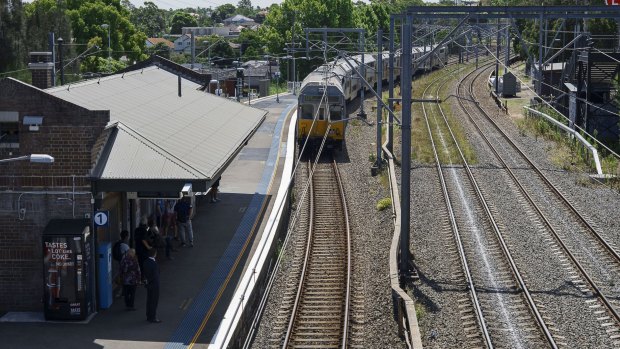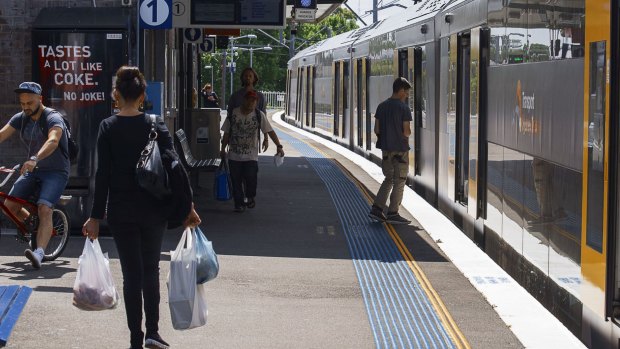By Matt O'Sullivan
Driverless trains might save the NSW government on wages but it turns out the old passenger trains that have relied on humans to ply Sydney's railway lines for decades can still go places their replacements can't – curved platforms at train stations.
One of the challenges confronting engineers labouring on Australia's largest public transport project is the need to straighten curved platforms at 11 existing stations from Sydenham to Bankstown to cater for new single-deck metro trains. They will run on Sydney's new metro line that will stretch from Rouse Hill in the northwest to Bankstown via Chatswood, the CBD and Sydenham in the south.

Curved platforms such as the one at Dulwich Hill in the inner west present challenges for builders of Sydney's new metro line.Credit: Christopher Pearce
"One of the things that has taxed us is that they are significantly curved platforms," Sydney Metro program development director Luke Franzmann told about 500 people at an industry briefing on Friday. "That is something we want to test with industry."
Unlike the double-decker trains such as the S-Sets and Tangaras that ply the existing Bankstown Line, the driverless metro trains will need to stop at exact positions on platforms to allow for barriers to open for passengers.

All of the stations on the Bankstown Line are in for a "major overhaul", which includes straightened platforms.Credit: Christopher Pearce
While train drivers will be sacrificed, the benefits for passengers will be level access and smaller gaps between carriages and platforms. In contrast, some existing platforms in Sydney require passengers to make a small step on or off carriages.
While the metro line from Chatswood to Sydenham involves digging twin 15-kilometre tunnels via new stations at spots such as Martin Place and Pitt Street in Sydney's CBD, the extension to Bankstown will require upgrading the existing 13.5 km railway, including a realignment of the track in places. Nine stations are located between Sydenham and Bankstown, including at Marrickville, Dulwich Hill, Canterbury and Lakemba.
Mr Franzmann said the conversion of the existing line to one that was capable of handling high-frequency driverless trains would be a challenge, especially given the rail corridor was more than a century old.
The project team had to consider a "major overhaul" of all of the stations on the Bankstown line because of the desire to "achieve a metro product", which includes platform edge barriers, better accessibility for passengers and lifts at every stop.
The Baird government is also on the cusp of deciding whether the metro line will go via a new station at Waterloo or Sydney University. Regardless of which site is selected, calls are likely to be made for another station further south because of the significant stretch of track to Sydenham.
However, Sydney Metro project director Rodd Staples said there were no plans or provisions made to allow for another station to be built in future years.
"In our early considerations ... we didn't identify anything with a strong case south of the Sydney University or Waterloo area, and we didn't receive any strong representations though the last consultation process," he said.
Mr Staples said it would be difficult to add another station to the underground line in future years because of the major construction and tunnelling work required. "It is different on the surface, but underground stations are very hard," he said.
"Obviously we would love to put more stations on .. but you have to balance that off with the travel time impact for the broader group of people because every time you have a station you have to stop."
The project team is investigating what it might do if a station is not built at Waterloo or Sydney University, such as upgrading Redfern station, for example, if the university is not chosen as a site.
The environmental impact statement for the metro line from Chatswood to Sydenham will be released in the middle of next year, while that for the conversion of the existing Bankstown line will be out several months later.
The total cost of the second stage of the project from Chatswood to Bankstown has been put at between $9.5 billion and $11 billion.
It is on top of the $8.3 billion Northwest line from Cudgegong Road to Epping and Chatswood, which includes twin 15-kilometre tunnels, a 4km rail bridge and eight new stations. Tunnelling on the Northwest line is more than 90 per cent complete, and is on track to be opened to trains in early 2019.
The existing Epping to Chatswood Line will be closed for seven months in late 2018 or early 2019 to make it make it able to handle the metro trains. However, the government is yet to reveal how long the Bankstown Line will be shut.